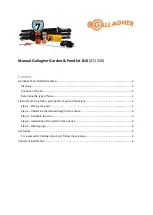
47
POST-INSTALLATION TESTS AND INSPECTIONS
After commissioning, the entire installation must be inspected and a running test must be carried out. Proceed as follows: use a fall-arrest harness and
system that is recommended for the installation in question. Connect one side of the FA 60 206 00 or FA 60 206 01 rope grab to the lifeline and the other
to the fall arrest system via a connector and carry out a running test by moving along the system and checking that the rope grab can run freely along
the entire length of the system.
It is also recommended that the installation is verified in an appropriate fashion, e.g. by calculation or testing.
A tensile force test must be carried out in situ to verify the solidity of the structural anchors in concrete, masonry and stone work. Carry out tensile
strength tests on the structural anchors by subjecting each one to a tensile force of 5 kN for 15 seconds.
Warning!
Take precautions when carrying the
above tests and ensure they are done under favourable conditions (flat supporting surface for positioning the measuring device, support points outside
the concrete cone failure area as define by the manufacturer where applicable, etc.) so as not to damage the installation.
KRATOS SAFETY declines any
liability for damage sustained by the system and/or installation during these tests.
The KS-Line lifeline complies with standards EN 795:2012 and TS 16415:2013 Type C and has been tested by a notified body. In-situ standards or
regulatory testing can damage the system and may be destructive. KRATOS SAFETY cannot be held liable for components that are damaged in the
course of tests carried out on an anchorage device.
At the end of the installation, check to make sure that none of the components have been damaged during installation. Check that the receiving structure
has not been damaged and that its integrity and strength have been maintained.
Fill in all the ENTECH01-related documentation (downloadable from our website) in accordance with EN 795:2012 and submit to the operator.
The installation can be verified by an approved body (recommended but not compulsory).
KRATOS SAFETY
offers two types of anchorage system training:
- Installation training
- Inspection training
Only persons who have undergone the above training are authorised to install and inspect KS-Line systems.
TRAINING
*
WARNING:
Before embarking on any installation, check that the available clearance underfoot (available fall height) shown on the data plate is compatible with
the fall arrest system used. This is to prevent users from colliding with the ground or an obstacle while their fall is being arrested. These checks
must take into account the position of the anchorage device, the fall arrest system used and the cable deflection (see diagram below for clarification).
H = height of the lifeline
f = cable deflection
L = length of the absorber lanyard
EA = energy absorber extension
T = height of the user
SD = safety distance = 1 m
FC = fall clearance
To check whether the available
clearance is suitable for the fall arrest
system used, the following formula
should be applied:
f+L+EA+T+SD-H < FC
















































